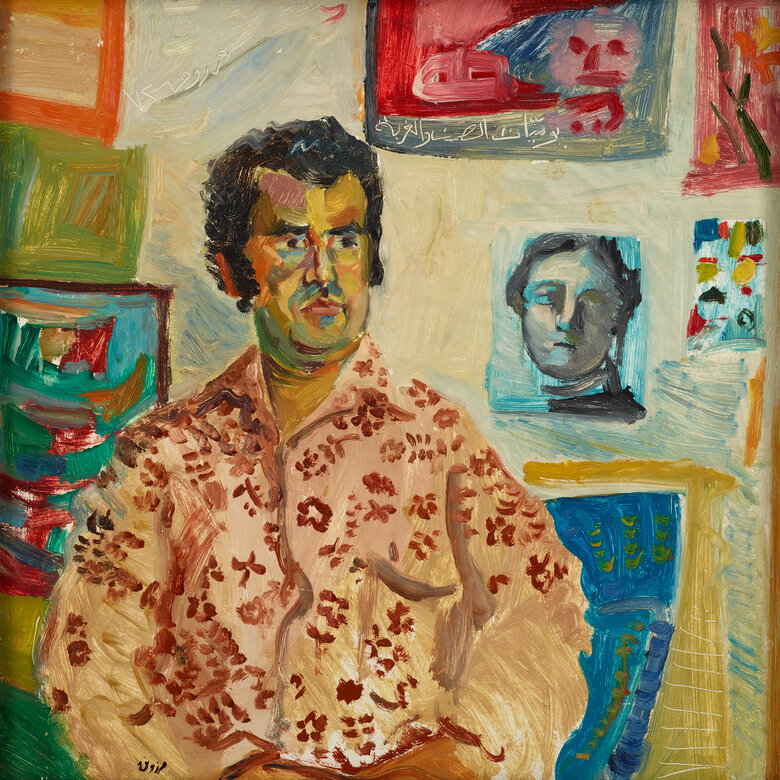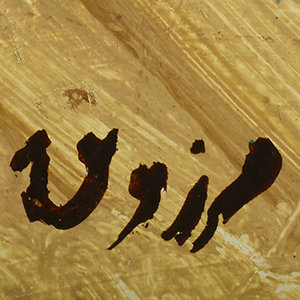Lebanese artist Ibrahim Marzouk was born in 1937, in the heart of Beirut. Growing up in the old souks, where his father owned an Arabic pastry shop, he was attached to his home city, and as an...





Lebanese artist Ibrahim Marzouk was born in 1937, in the heart of Beirut. Growing up in the old souks, where his father owned an Arabic pastry shop, he was attached to his home city, and as an...
Lebanese artist Ibrahim Marzouk was born in 1937, in the heart of Beirut. Growing up in the old souks, where his father owned an Arabic pastry shop, he was attached to his home city, and as an adult, he began his art education a stone’s throw from where he was born.
From 1954 to 1958, Marzouk studied at the Lebanese Academy of Fine Arts (ALBA) in Beirut. In 1959, he received a grant from the Indian government to spend a year abroad and left his home for Hyderabad, the capital of the Indian state of Telangana. He joined the Institute of Fine Arts there in 1960. His time in India marked a shift in style for Marzouk, especially as concerns his use of color; where, in Lebanon, the artist had relied on more muted tones in his composition, in India he began to incorporate bright, explosive hues. These choices reflected the impact of his surroundings, as he engaged with a culture that valued vivid colors in art as well as in quotidian visual culture.
Upon his return to Lebanon the next year, Marzouk found himself uncomfortable exhibiting the paintings he had produced during his sojourn in India. The aesthetic tides had shifted in his home country, and a trend of Cubist-inspired abstraction was starting to take hold among the city’s artistic elite. His work was not heading in this direction and, feeling estranged from the local art scene, he decided to bury the Indian period paintings in the corner of his studio until 1965 when he would revisit them for possible exhibition.
The artist’s second formative trip was to Italy, from 1965 to 1968, when he received a grant from the Lebanese government to study at The Accademia di Belle Arti of Rome. As in India, Marzouk drew inspiration from his surroundings, representing local subjects –streets, cafés, marketplaces, people– through his unique personal lens. His work from this period is characterized by a lively, vibrant use of color, as well as animated brushstrokes that lend a sense of vitality to portraits and cityscapes alike. His canvases record his reactions to the world around him, expressions on canvas of his perception of reality rather than pretentions to objective realism. The artist’s moods and viewpoints impacted each work differently, shining through in both his choices of color palette and his handling of paint. Through charcoal, watercolor, and pastel sketches, as well as his better-known oil paintings, the artist depicted a world of organized chaos. These ordinary scenes seem to barely subdue a buzzing of intense emotion.
However far he strayed from Lebanon, Marzouk’s favorite subject remained Beirut. During the Lebanese “golden era” before the civil wars, he witnessed his newly independent country thrive economically as it modernized rapidly. He responded to this not by celebrating so-called “progress,” but with nostalgia, painting the souvenirs of his Beiruti childhood: black cats on rooftops, paper planes, old Lebanese villas with their beautiful, sloping windows. His dreamlike compositions echo those of his contemporaries, such as Amin El Bacha and Rafic Charaf, insofar as they subtly reflected his belief that national identity was under threat by westernization. Like El Bacha and Charaf, his investment in “salvaging” the Arab heritage of Lebanon came through in mundane scenes of everyday life; rather than strident nationalism, they glorified his own past, showing a more personal relationship to a mythical former Lebanon.
In the wake of the Six-Day War of 1967 and rising sectarian tensions in Lebanon, he began to look inwards, introverted, in search of purity and security. His works from the later years of his career show their audience another side of the artist, an anti-social, isolated facet of his personality that grew with rising civil unrest. He painted corners of his studio and other domestic spaces, resizing and distorting ordinary objects – often children’s toys, such as wooden horses and dolls, or sentimental keepsakes, like seashells– such that they transformed into vast landscapes. Feeling oppressed by his country’s political situation, he would cling to memories of better days, recreating zones of comfort into which he would sometimes place himself through, for example, a reflection in the mirror. Even in his most “secure” spaces, however, the artist’s unease seeps through his formal choices. A glimpse of his mirrored face wearing a melancholy expression, the agitation of swift, dynamic brushstrokes, the “noise” of “loud,” aggressive colors in an otherwise tranquil scene –through these and more, Marzouk communicated his deteriorating emotional state as his nation marched towards the outbreak of war.
During the final years of his career, from 1970 to 1975, Ibrahim Marzouk taught at the Faculty of Fine Arts of the Lebanese University. A complex individual, he was a bon vivant despite the mounting anxieties he expressed through his paintings; a beloved instructor as well as a visual artist, he was also a singer, a musician, a writer, and a humorist. Tragically, his life was cut short, mere months into the civil wars, when, on October 8th, 1975, he fell victim to a bomb dropped on a local bakery while buying bread for his family. Famed Palestinian author Mahmoud Darwish wrote a poem in memory of Ibrahim Marzouk.
Sources
“Collections: Marzouk Ibrahim.” Gallerie Tabbal. Accessed August 5, 2019.
http://www.galerietabbal.com/Collections.aspx?CollectionID=49&Page=2
“Events: Where to Go: Saleh Barakat Exhibition: 15 July, 24 August 2019.” One Fine Art. Accessed August 6, 2019.
https://www.onefineart.com/events/Saleh-Barakat-Gallery-flowers
G. A. “Actualités: Peinture - Dans le stand offert par la Foire de Genève Un tableau en 21 touches de l'art contemporain libanais (photos).” L’Orient Le Jour. April 2, 1999. Accessed August 7, 2019. https://www.lorientlejour.com/article/315660/Peinture_-_Dans_le_stand_offert_par_la_Foire_de_Geneve_Un_tableau_en_21_touches_de_lart_contemporain_libanais%2528photos%2529.html
“Ibrahim Marzouk: The transcendence of the intimate visions.” National Museum of Modern Art Virtual website. Accessed August 6, 2019.
http://artmodernemv.gov.lb/english/ibrahim-marzouk
“Painters: Ibrahim Marzouk.” One Fine Art. Accessed August 6, 2019. https://www.onefineart.com/artists/painters/Ibrahim-Marzouk
“Painter.” Ibrahim Marzouk Arts. 2014. Accessed August 5, 2019. https://ibrahimmarzouk.webs.com/painter
“Pick of the Day: At Auction (catalogue).” Agenda Culturel. October 2016. http://www.agendaculturel.com/POD_At_Auction_Octobre_2016
“Press: Alliwaa, March 1975.” Ibrahim Marzouk Arts. 2014. Accessed August 5, 2019. https://ibrahimmarzouk.webs.com/painter
Salamé Abillama, Nour and Marie Tomb. Art From Lebanon – Modern and contemporary artists 1880-1975, Volume I. Beirut: Wonderful Editions, 2012.
Tarrab, Joseph. “Actualités: Regard Ibrahim Marzouk: oeuvres inédites L'homme à la tête coupée.” L’Orient Le Jour. January 17, 1998. Accessed August 7, 2019. https://www.lorientlejour.com/article/249713/Regard_Ibrahim_Marzouk_%253A_oeuvres_inedites__Lhomme_a_la_tete_coupee.html
The Alumni Association of the Lebanese American University. “human figure in Lebanese painting: a collective art exhibition.” Instazu. June 2019. Accessed August 6, 2019. https://www.instazu.com/media/2063257593733634385
“Three Brave New Exhibitions of Art.” The Daily Star, Lebanon. January 1998. Accessed August 6, 2019. http://www.dailystar.com.lb/ArticlePrint.aspx?id=102923&mode=print
Zalzal, Zéna. “Actualités: Exposition - À la galerie Aïda Cherfan, jusqu’au 31 mars Hommage à Ibrahim Marzouk, l’un des peintres du Beyrouth d’avant-guerre (Photo).” L’Orient Le Jour. March 19, 2005. Accessed August 8, 2019. https://www.lorientlejour.com/article/497710/Exposition_-_A_la_galerie_Aida_Cherfan%252C_jusqu%2527au_31_marsHommage_a_Ibrahim_Marzouk%252C_l%2527un_des_peintresdu_Beyrouth_d%2527avant-guerre_%2528Photo%2529.html
Zalzal, Zéna. “Artistes Arabes… À la manière italienne.” L’Orient Le Jour (Beirut, Liban), April 11, 2008.
سلطان، فيصل. كتاب السفير: كتابات مستعادة من ذاكرة فنون بيروت. بيروت: الفارابي. ٢٠١٣
Sultan, Faysal. The Book of the Ambassador: Writings Recovered from the Memory of the Art of Beirut. Al Farabi: Beirut. 2013.
Selected Solo Exhibitions
Aida Cherfan Gallery, Beirut, Lebanon
Galerie d’Art Bekhazi, Beirut, Lebanon
Janine Rubeiz Gallery, Beirut, Lebanon
Platform Gallery, Achrafieh, Lebanon
The home of Samia Toutounji, Be
Gallery One, Beirut, Lebanon
Lebanese Artists Association – Painters and Sculptors (LAAPS), Beirut, Lebanon
Madrid, Spain
Pisa, Italy
Paris, France
Lebanese Artists Association – Painters and Sculptors (LAAPS), Beirut, Lebanon
Lebanese Artists Association – Painters and Sculptors (LAAPS)
Selected Group Exhibitions
Beirut And The Golden Sixties: A Manifesto Of Fragility, Mathaf, Arab Museum of Modern Art, Doha, Qatar
Encounters 2023, Galerie Janine Rubeiz, Beirut, Lebanon
Nothing But Flowers, Saleh Barakat Gallery, Beirut, Lebanon
Lebanese Academy of Fine Arts (ALBA), Beirut, Lebanon
Art from Lebanon, Beirut Exhibition Center, Beirut, Lebanon
Italian Cultural Center in Beirut at Villa Audi, Achrafieh, Lebanon
Gallery Daniel Besseiche, Paris, France
Europ’Art, Geneva, Switzerland
Human Figure in Lebanese Painting, organized by the Alumni Association of the Lebanese American University, Beirut, Lebanon
Exhibition in honor of deceased artists with the Ministry of National Education and Fine Arts, Beirut, Lebanon
First Arab Biennale in Baghdad
UNESCO Palace, Beirut, Lebanon
Participated in the Biennales of Alexandria, Egypt
São Paolo, Brazil and Paris, France
Collections
Ramzi and Saeda Dalloul Art Foundation, Beirut, Lebanon
Collection of the Lebanese Ministry of Culture, Beirut, Lebanon
Join us in our endless discovery of modern and contemporary Arab art
Get updates from DAF
Follow Artists
Save your favourite Artworks
Share your perspectives on Artworks
Be part of our community
It's Free!
We value your privacy
TermsCookiesPrivacy Policies
Get updates from DAF
Follow Artists
Save your favourite Artworks
Share your perspectives on Artworks
Be part of our community
It's Free!
We value your privacy
TermsCookiesPrivacy Policies
Get updates from DAF
Follow Artists
Save your favourite Artworks
Share your perspectives on Artworks
Be part of our community
It's Free!
We value your privacy
TermsCookiesPrivacy Policies
If you have entered your email to become a member of the Dalloul Art Foundation, please click the button below to confirm your email and agree to our Terms, Cookie & Privacy policies.
We value your privacy, see how
Get updates from DAF
Follow Artists
Save your favourite Artworks
Share your perspectives on Artworks
Be part of our community
It's Free!
We value your privacy
TermsCookiesPrivacy Policies